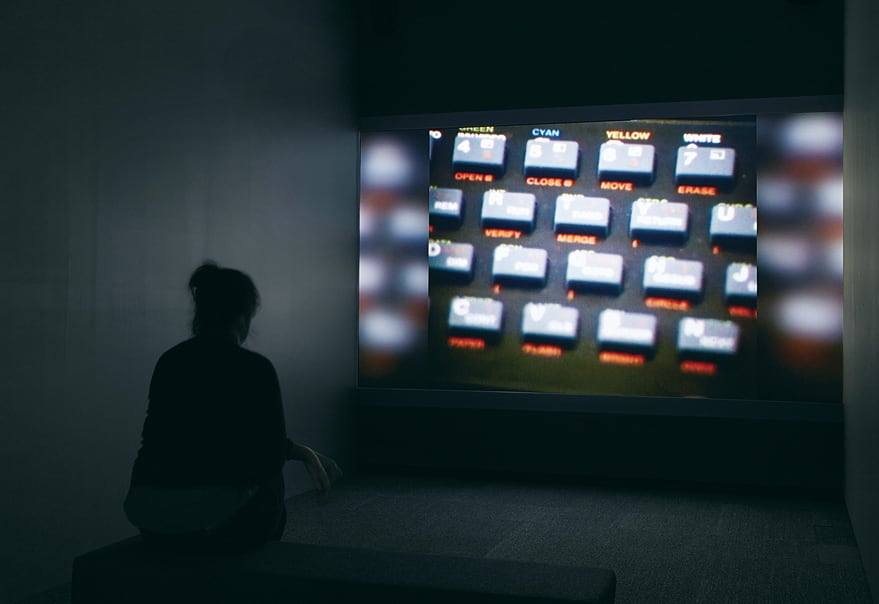 Contemporary art discourse is increasingly embracing recent theoretical trends that call for a focus on materialisms and material ontologies. In Melbourne in the last year alone we have seen the Transversal Practices conference on New Materialisms (and its satellite projects) alongside large institutional exhibitions that included The Biography of Things (2015, acca), Technologism (2015, muma), and Pierre Huyghe (2015, TarraWarra Museum of Art). All of these are underpinned by an ethos to take the dynamism and importance of the non-human world seriously. An umbrella term for this movement is the ‘material turn’ (MT): a rejection of the linguistic focus of Modernism and Postmodernism, as well as a destabilisation of the human exceptionalism of Humanist thought. While the ‘material turn’ is more commonly used to refer to the emergence of material culture studies, it is used here to gather together theoretical trends such as New Materialism, Object Oriented Ontology, Speculative Realism and Post-humanism. Within the MT, I find the ecological and relational perspectives most productive because they seek to capture the entangled, mutually dependent web of relationships that surround us. Examining the particularities of this connective tissue opens up a rich field of possibilities for making and thinking about art. Yet in applying these theoretical perspectives to artistic discourse there is a tendency to rely on, and become trapped by, categories that prevent a deeper poetic and critical discussion. By unpacking the terms ‘materiality’ and ‘agency’ we can see how, although sometimes useful, their overuse can obscure the multiple layers of relationships, social and non-social, that pervade our experience of the world.
Contemporary art discourse is increasingly embracing recent theoretical trends that call for a focus on materialisms and material ontologies. In Melbourne in the last year alone we have seen the Transversal Practices conference on New Materialisms (and its satellite projects) alongside large institutional exhibitions that included The Biography of Things (2015, acca), Technologism (2015, muma), and Pierre Huyghe (2015, TarraWarra Museum of Art). All of these are underpinned by an ethos to take the dynamism and importance of the non-human world seriously. An umbrella term for this movement is the ‘material turn’ (MT): a rejection of the linguistic focus of Modernism and Postmodernism, as well as a destabilisation of the human exceptionalism of Humanist thought. While the ‘material turn’ is more commonly used to refer to the emergence of material culture studies, it is used here to gather together theoretical trends such as New Materialism, Object Oriented Ontology, Speculative Realism and Post-humanism. Within the MT, I find the ecological and relational perspectives most productive because they seek to capture the entangled, mutually dependent web of relationships that surround us. Examining the particularities of this connective tissue opens up a rich field of possibilities for making and thinking about art. Yet in applying these theoretical perspectives to artistic discourse there is a tendency to rely on, and become trapped by, categories that prevent a deeper poetic and critical discussion. By unpacking the terms ‘materiality’ and ‘agency’ we can see how, although sometimes useful, their overuse can obscure the multiple layers of relationships, social and non-social, that pervade our experience of the world.
Following Materials
‘Materiality’ is widely used within artistic discourse to refer to the physicality of things, to capture a kind of productive force that material things share. Such a broad meaning allows for parallels to be drawn between many different kinds of things, be they physical objects or digital media. It is the state of physicality, rather than the specifics of a particular material, that therefore foregrounds translation and transformation. It becomes useful to think through the simulations of digital media: for example in the way images and objects circulate and transform in Hito Steyerl’s video, How Not To Be Seen: A Fucking Didactic Educational .MOV File (2013), as part of the Technologism exhibition. The boundaries between the physical and digital worlds blur, a situation emphasised in Technologism, where the video extends into sculptural installation. Yet the tendency to rely on materiality as shorthand for physicality can homogenise the vast variability of the material world. For the anthropologist Tim Ingold, speaking through ‘materiality’ abstracts away from actual physical experience, leading to the invisibility of the qualities and properties of material themselves.1 Materiality is something ‘out there’, formless and separate from its interactions with the world. Ingold argues that this perpetuates the divide between the mental and the physical, emphasising the consumption of static objects rather than the production and fluidity of things.2 To counteract this view, he advocates a language that attends to the materials themselves first, a perspective that views the world as ‘an ocean of materials’, continually moving, changing and forming.3 Here materials aren’t static or ahistorical, they are always caught up in entangled relationships of change. He encourages thinking like a craftsperson, in which new forms emerge, not from imposition of design onto inert matter, but from a ‘process of correspondence’ between materials and humans, a push and pull, an entanglement.4 Ingold’s writing provides an important reminder that to do justice to the physical world, artistic discussions need to privilege the phenomenological way in which we, as humans, experience our environment and the materials of the world.Agency
things are active not because they are imbued with agency but because of ways in which they are caught up in these currents of the lifeworld — Tim Ingold5A central task of those associated with the MT is to describe an active world, in which humans are not alone as actors. Theorists like Bruno Latour have popularised the notion that the material world has agency alongside — and with — that of the social world.6 Yet, while a deep analysis of the entangled connections and correspondence of actions that includes nonhuman alongside the human is important, the concept of ‘agency’ has a tendency to become a homogenous category that doesn’t necessarily allow the quality and form of these influences to become obvious.7 This is because agency is not a uniform ‘thing’ that can be held, but a particular kind of interaction. This notion of agency emerged from the social sciences in the mid-twentieth century to describe the way in which individuals can or cannot choose to act within the wider social and cultural structures.8 Emphasising questions of freedom, free will and choice, it has, at times, been criticised for being closely related to Western notions of autonomous individuality.9 This is important because it shows that agency is a culturally specific frame of reference not a neutral description. To speak then only of the ‘agency’ of objects and other non-humans gives an overly broad and limited understanding of the multiple forces that channel actions. While it is not uncommon for objects to act as social persons in certain situations, conceptualising matter in terms of an autonomous actor can have wide ramifications.10 Using agency broadly, and without differentiation, not only simplifies narratives, but can also hide the social inequalities built into the contemporary world.
Divergent Paths:
the art historian’s goal is to provide readers and viewers with conditions for more open-ended hermeneutics or interpretive play, postponing the final displacement of the visual by the verbal’. — Ladislav Kesner16 The condition of art writing feels like one of perpetual failure, of hoping to capture something about an artwork without reducing it to that description. With this struggle though comes the possibility of opening up an artwork to a broader set of perspectives, of forging new connections. On a large scale, my concern with labels like ‘materiality’ and ‘agency’ is that they can replace other descriptive modes, locking artworks into a particular theoretical perspective and displacing the artwork itself. In particular, this is exacerbated when the labels themselves work against the intentions of the artwork or discursive argument. These terms do not capture the interconnected multiplicity of the material world; they can flatten the small narratives and differences, the push and pull of materials. In doing so they stop the search for new and more poetic forms of description, a restless attempt to understand the dynamism of our entangled lives.Anatol Pitt has a degree in anthropology and art history from the University of Melbourne and is a fine art undergraduate at the Victorian College of the Arts. The companion piece to this article Moss, thoughts on entanglement, representation and the material world, that imagines the relational intersection of self, moss garden and artistic practice is available online as part of un Extended 10.1.
1. Tim Ingold, ‘Materials Against Materiality’, Archaeological Dialogues, vol. 14, no. 1, 2007, pp. 2–3.
2. Ingold distinguishes between talking of ‘objects’, which focuses on bounded artifacts, and ‘things’ which is a more flexible descriptor. See: Tim Ingold, ‘Toward an Ecology of Materials’, The Annual Review of Anthropology, vol. 41, 2012, p. 436.
3. Ingold, 2007, p. 7.
4. Ingold, 2012, p. 435.
5. Ingold, 2007, p. 1.
6. Bruno Latour, An inquiry into the modes of existence: An anthropology of the moderns, Harvard University Press, Cambridge MA, 2013.
7. This lack of differentiation between the agency of humans and nonhumans alike has been a criticism of Latour’s models. See Andrew B Kipnis, ‘Agency between humanism and posthumanism: Latour and his opponents’, HAU: Journal of Ethnographic Theory, vol. 5, no. 2, pp. 43–58.
8. Steven Hitlin and Glen H. Elder, Jr, ‘Time, Self and the Curiously Abstract Concept of Agency’, Sociological Theory, vol. 25, no. 2, 2007, p. 170.
9. Ibid., p. 171.
10. The exploration of how the subject-object boundary changes has been a common thread throughout the history of anthropology see: Janet Hoskins, ‘Agency, Biography and Objects’, in Chris Tilley, Webb Keane, Susanne Küchler, Mike Rowlands and Patricia Spyer (eds.) Handbook of Material Culture. London: Sage, 2007.
11. Alf Hornborg, ‘The political economy of technofetishism: Agency, Amazonian ontologies, and global magic’, HAU: Journal of Ethnographic Theory, vol. 5, no. 1, 2015, pp. 35–57.
12. Ibid., p. 49.
13. Ibid., pp. 48–50.
14. Ibid., p. 50.
15. Ibid., p. 49.
[^16]: Ladislav Kesner, ‘Is A Truly Global Art History Possible?’ in Is Art History Global [online], James Elkins (ed.), Routledge, New York, 2007, pp. 92..jpg)

